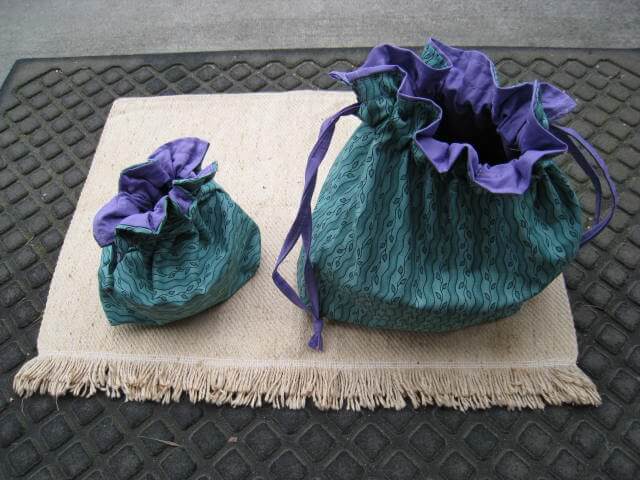The order was for one #118 mallet, our cutest dinkiest [wool-head] traditional Nepalese mallet, together with two cover cloths, one royal blue with gold “Profound Sounds” embroidering, one velvet, Tibetan monk red, also with the gold “Profound Sounds” embroidering. It all fits neatly in a USPS Small Flat Rate box. Very pleasing. Now I will…
Tag: Singing bowl
Singing bowls in one-off hand-made pouches

Displayed on end-cap in Santa Cruz, CA, in the original Staff of Life Natural Food Store. Besides these select few, which happened one holiday season at the express request of the store buyer, every now and again through the years a singing bowl has gone to its new home/owner in one of these special hand-made…
Another bird and bowl story
Corrina takes a very special big Lingham bowl out and sits with it on the river levee at dawn – just her, her bicycle and the singing bowl. Two black crows are flying overhead and they come down and land on the bike path not more than ten feet away. She keeps ringing the singing…
Doing business in Kathmandu
I’m in the internet shop in a side alley, one of the good ones with instant backup power for when the electricity goes down. All of a sudden lots of noise and yelling on the main street. Then some loud bangs and people run past the door. The shop guys jump up, go outside and…
Singing bowl experience set-up
We arrive at the yoga studio in the late afternoon darkness. It is so quiet and orderly in there, the floor gleams – a tabula rasa for my layout. I need 100 square feet for the singing bowls. First I lay down yoga mats two deep, soft but not too squishy. On top of the…
Singing bowls at the end of life
I have a friend very near the end of his days – so near he’s past the doctors and into hospice care. This friend has a lifetime of involvement with Tibetan Buddhism and is spending his remaining time focused on his practice, sort of shining up his mind to best be able to engage with…
Somehow they figured it out
without ever hearing about germ theory In Nepal I was told that people liked to use copper and brass utensils for their healthful qualities. What these exact qualities consisted of was not made explicit but faith in the concept was strong. People believed that food stored in brass was rendered more potent somehow. Well, it…
A Nepali singing bowl practitioner in the US
I went to see a presentation by a practitioner of Tibetan sound healing. He was a Nepali man, very sincere, who was practicing what he called a dying art in his native country. In the course of his discussion he spoke of many instances where people had experienced healing through hearing the tones of his…
Deep Resonance
A very interesting study by Cornell University entomologists involved in developing non-chemical methods of mosquito control caught my ear this week. In a paper published in the February issue of Science magazine it was reported that sonic resonance is the key to inducing female mosquitoes to mate. The way it works is this. Male mosquitoes…












